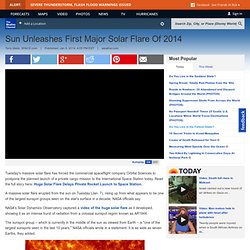

S0 News June 27, 2014. Unable to Track CMEs? Systems Are Shut Down. The Sun Has Been Very Busy. Our Sun Has Been Very Busy.

Space weather refers to everything the Sun throws at us – from the continuous stream of charged particles it constantly spews out, called the solar wind, to the belches of eruptions, ejections and flares. Many people have been commenting on how quiet the sun has been recently. Well that has certainly changes in a big way and very quickly! Is this the calm before the storm? In the last 12 hours, the Sun has experienced five solar flares. Mage of the Sun showing the sunspots that have caused all these flares So what does this mean to us on Earth? Image of one of the flares. However, we will likely see an uptick in northern light activity Friday night and this weekend.
Map of where the northern lights may be seen according to Kp levels Alex Young, a heliophysicist at NASA Goddard, said the space agency is keeping a watchful eye on the sun’s increased activity, but downplayed the chances of a catastrophic hit on Earth. Solar Wind Mystery. June 11, 2014 Sun Erupts With 3rd Major Solar Flare in 2 Days. The sun is hitting its stride.

Earth's closest star shot off yet another powerful solar flare today (June 11) after producing a pair of major solar storms Tuesday. An X1 solar flare bursts off the left limb of the sun in this image captured by NASA's Solar Dynamics Observatory on June 11, 2014, at 9:05 a.m. EDT. Credit: NASA/SDO/Goddard. Mar 12, 2014 Sun Unleashes Intense Solar Flare as NASA Watches (Video) Feb 25, 2014 Sun Solar Flare Captured by NASA SDO [Video] An active sunspot erupted with a solar flare on February 25, 2014.
![Feb 25, 2014 Sun Solar Flare Captured by NASA SDO [Video]](http://cdn.pearltrees.com/s/pic/th/solar-flare-captured-video-88931108)
The sunspot, currently designated AR11990, is on its third trip around the sun since originally being tracked. AR11990’s trip around the sun is approximately 27 days. A high-definition video of the Sun’s recent solar flare was captured by NASA’s SDO mission. NASA’s Solar Dynamics Observatory (SDO) was the first mission launched under the Living With a Star Program. The LWS program was created to research, observe, and better understand the Sun’s influence on the space around Earth and on Earth itself. Jan 8, 2014 Sun Unleashes First Major Solar Flare Of 2014.
Tuesday's massive solar flare has forced the commercial spaceflight company Orbital Sciences to postpone the planned launch of a private cargo mission to the International Space Station today.

Read the full story here: Huge Solar Flare Delays Private Rocket Launch to Space Station. A massive solar flare erupted from the sun on Tuesday (Jan. 7), rising up from what appears to be one of the largest sunspot groups seen on the star's surface in a decade, NASA officials say. NASA's Solar Dynamics Observatory captured a video of the huge solar flare as it developed, showing it as an intense burst of radiation from a colossal sunspot region known as AR1944. The sunspot group – which is currently in the middle of the sun as viewed from Earth – is "one of the largest sunspots seen in the last 10 years," NASA officials wrote in a statement. It is as wide as seven Earths, they added. Dr. Soon: Solar TSI and Climate Change (2014 ICCC)
Solar Flare, External Forcing. Giant solar flare welcomes earth. Solar Flare Will Hit Earth Thursday; Northern Lights May Expand South. Hide captionComing At You: An image created by NASA combines two pictures from its Solar Dynamics Observatory.

One shows the location of a large sunspot; the other shows Tuesday's massive solar flare. Coming At You: An image created by NASA combines two pictures from its Solar Dynamics Observatory. One shows the location of a large sunspot; the other shows Tuesday's massive solar flare. Tired of reading about intensely cold temperatures? Here's some news that might help take your mind off this week's deep freeze. An intense solar flare is being blamed for disrupting a NASA mission and could force airlines to reroute some flights. Update at 3:15 p.m. The coronal mass ejection was observed "just upstream of Earth" at 2:32 p.m.
But NASA's Space Weather Prediction Center also notes, "Aurora watchers may be in luck for tonight. The agency says to expect S3 (strong) geomagnetic storm activity on Jan. 9 and 10. Update at 1:45 p.m. Our original post continues: Biggest Solar Flares of 2014: Sun Storm Photos.